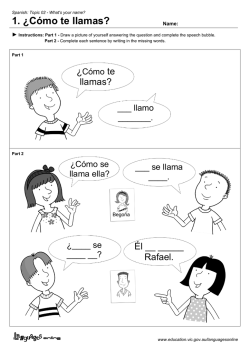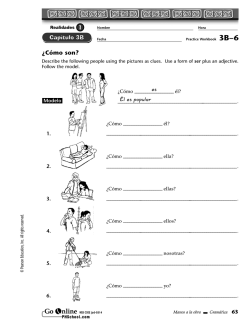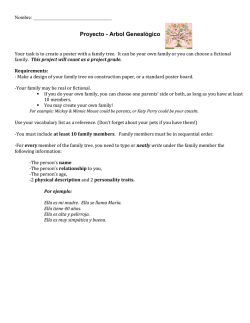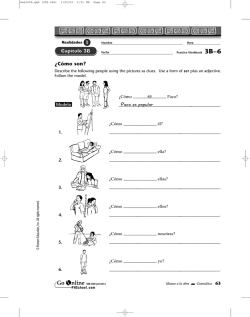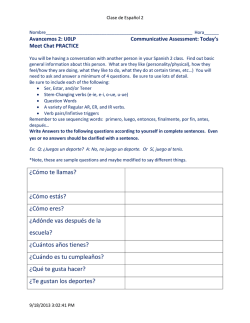
Document
Nombre Clase Fecha CAPÍTULO 1 ¡Empecemos! VOCABULARIO 1 1 2 Today is the first day of school, and you are getting to know your teacher and classmates. Match each situation to the expression you would use. e 1. to introduce yourself f 2. to ask who a certain girl is a 3. to ask a classmate his name b 4. to tell who another boy is d 5. to ask someone a boy’s name g 6. to ask the teacher her name c 7. to say who the girl next to you is a. ¿Cómo te llamas? b. Él es Pedro. c. Ella es Elsa. d. ¿Cómo se llama él? e. Soy (your name). f. ¿Quién es ella? g. ¿Cómo se llama usted? Write how you would greet each person below. Be sure to ask some people how they’re doing. Answers will vary. Possible answers: 1. Mr. Tanaka, in the morning Buenos días, señor. 2. Your friend, at school Hola. ¿Cómo estás?/¿Qué tal? 3. Mrs. Wilson, in the afternoon Buenas tardes, señora. 4. Mrs. García, in the evening Buenas noches, señora. 5. Mr. Acero, before noon Buenos días. ¿Cómo está usted? 3 Look at the illustrations. Then provide an appropriate response to tell how each person is feeling, following the modelo. Answers will vary. Possible answers: MODELO —Buenos días, señora. ¿Cómo está usted? —Estoy bien, gracias. 1. —Hola, Luisa. ¿Cómo estás? —Estoy regular. / Estoy mal. MODELO 1. 2. 3. 2. —Hola, Bernardo. ¿Qué tal? —Más o menos. 3. —Buenas tardes, señora. ¿Cómo está usted? —Estoy bien. Holt Spanish 1 Copyright © by Holt, Rinehart and Winston. All rights reserved. Cuaderno de vocabulario y gramática 1 Nombre Clase Fecha CAPÍTULO 1 VOCABULARIO 1 4 Marissa and her friends are saying good-bye after a party. Can you think of five different expressions they might use? The first one has been done for you. Answers may vary. Possible answers: 1. Marissa: Tengo que irme. 2. Carlos: Hasta mañana. 3. Alexis: Buenas noches. 4. Reba: Hasta luego. 5. Zula: Adiós. 5 Verónica is looking at a friend’s pictures and wants to know who each person is. Write her friend’s response for each picture. The first one has been done for you. Answers will vary. Possible answers: 1. Patty 2. Carlos 3. Makiko 4. mi amiga Ani 5. mi amigo Juan 1. ¿Quién es ella? Ella es Patty. 2. ¿Quién es el muchacho? Él es Carlos. 3. ¿Quién es ella? Ella es Makiko. 4. ¿Quién es la muchacha? Ella es mi amiga Ani. 5. ¿Quién es él? Él es mi amigo Juan. 6 For each of the expressions below, write one (in Spanish) with the same or a very similar meaning. 1. ¿Qué tal? ¿Cómo estás? 2. Soy Alejandra. Me llamo Alejandra. 3. Hasta pronto. Hasta luego. / Nos vemos. 4. ¿Cómo se llama él? ¿Quién es él? Holt Spanish 1 Copyright © by Holt, Rinehart and Winston. All rights reserved. Cuaderno de vocabulario y gramática 2 Nombre Clase Fecha CAPÍTULO 1 VOCABULARIO 1 7 Choose the correct ending for each incomplete sentence. MODELO c a c b 8 b Julián es a. regular b. un amigo c. una profesora 1. Alicia es mi . a. compañero de clase b. profesor de ciencias c. mejor amiga 2. Éste es . a. Claudio b. la señora López c. encantado 3. Ella se llama . a. mi mejor amiga b. Antonio c. Ana María 4. Ésta es . a. encantada b. la señora Escamilla c. un amigo Look at the chart below and write the questions to the answers given. The first one has been done for you. Jessica Estados Unidos 9 . Jennifer Costa Rica Iván Puerto Rico Señora Ruiz Bolivia 1. ¿De dónde eres tú, Jessica? Yo soy de Estados Unidos. 2. ¿De dónde es Jennifer? Ella es de Costa Rica. 3. ¿De dónde es Iván? Él es de Puerto Rico. 4. ¿De dónde es usted? Yo soy de Bolivia. Marla is introducing her friends to Julián. Fill in the blanks with appropriate expressions to complete their conversation. Answers may vary. Possible answers: Marla Victoria Julián Victoria Julián Victoria Marla Julián Victoria, éste es Julián. Hola, Julián. (1) Mucho gusto. / Encantado. ¿De dónde eres, Julián? (2) Soy de (3)¿ De dónde Cuba. ¿Y tú? eres? Soy de San Francisco, California. ésta es Julián, (4) (5) Angélica (6) Angélica. Encantado. / Mucho gusto. Igualmente. Holt Spanish 1 Copyright © by Holt, Rinehart and Winston. All rights reserved. Cuaderno de vocabulario y gramática 3 Nombre Clase Fecha CAPÍTULO 1 ¡Empecemos! GRAMÁTICA 1 Subjects and verbs in sentences • The subject of a sentence is the person, place, or thing being described or performing an action. It can be a noun or a pronoun (a word that replaces a noun such as él or ella). El señor Garza es profesor de español. Él es de España. Mr. Garza is a Spanish teacher. He is from Spain. • The verb is the action the subject is performing or the word that connects the subject to a description (a word like soy/eres/es). Alicia es estudiante. Yo soy de México. Alicia is a student. I am from Mexico. • In Spanish, the subject can be left out if it is clear who or what is being described. Juan es mi amigo. Él es de Paraguay. or Es de Paraguay. Juan is my friend. He is from Paraguay. 10 Write the subject and the verb of each sentence on the lines that follow it. MODELO Mi amigo es de España. subject: Mi amigo verb: es Yo soy 1. Yo soy Vicente. subject: verb: 2. Marta es mi compañera de clase. subject: Ella 3. Ella es de California. subject: Marta verb: verb: es 4. El señor Porta es mi profesor. subject: El señor Porta verb: Él 5. Él es el señor Ortiz. subject: 11 verb: es es es Unscramble each set of words to make a complete sentence. Capitalize letters and add punctuation where appropriate. MODELO es / Bolivia / mi amiga / de Mi amiga es de Bolivia. 1. de / Javier / México / es Javier es de México. 2. es / mi mejor amiga / ella Ella es mi mejor amiga. 3. mi profesor / es / él / de ciencias Él es mi profesor de ciencias. 4. una compañera / Rosa / de clase / es Rosa es una compañera de clase. Holt Spanish 1 Copyright © by Holt, Rinehart and Winston. All rights reserved. Cuaderno de vocabulario y gramática 4 Nombre Clase Fecha CAPÍTULO 1 GRAMÁTICA 1 Subject pronouns in Spanish One person yo More than one person nosotros (males or mixed group) nosotras (all female) I we tú (familiar) usted (formal) you vosotros (all males or mixed group, in Spain) you vosotras (all females, in Spain) ustedes (males and/or females) él ella he she ellos (males or mixed group) ellas (all female) 12 What pronoun would you use to talk to these people? The first one has been done for you. usted 1. your friend’s father 5. a group of school children 3. a group of several girls from Spain in Spain vosotras vosotros usted 6. your teacher What pronoun would you use to talk about these people? The first one has been done for you. 4. yourself 1. your two best friends, both female ellas 5. your sister ellos 2. your big brothers 6. your father a girl yo ella él 7. your uncle, your aunt, 3. your two neighbors, a boy and 14 ustedes 4. two classmates tú 2. your friend 13 they ellos and yourself nosotros Write the pronoun that you would use for each of the following subjects in Spanish. MODELO Elvira y tú ustedes él 1. Ricky 2. Mis amigas y yo (all girls) ellos 3. Víctor y Ricardo 4. Julieta nosotras ella 5. Robert y tú (in Spain) 6. Rosa y Mónica vosotros ellas Holt Spanish 1 Copyright © by Holt, Rinehart and Winston. All rights reserved. Cuaderno de vocabulario y gramática 5 Nombre Clase Fecha CAPÍTULO 1 GRAMÁTICA 1 15 Look at the following list of subject pronouns and check all the boxes that apply to each. The first one has been done for you. Subject pronoun One person More than one person Male(s) X X Ellos Ella Female(s) X X X Ustedes X Ellas X X Nosotras X X Usted Él X X X X X Vosotros X X X X Tú X X X Vosotras 16 X X Nosotros Males and females X X X X X Rewrite the following sentences by replacing the subject with a pronoun. MODELO Mariano es de Ecuador. Él es de Ecuador. 1. Doug es un estudiante de San Francisco, California. Él es un estudiante de San Francisco, California. 2. La muchacha es mi amiga. Ella es mi amiga. 3. Bruce y Roberto son (are) estudiantes. Ellos son estudiantes. 4. Maribel y yo somos (are) de España. Nosotros/Nosotras somos de España. 17 In the conversation below, write on each line the subject pronoun that has been left out. The first one has been done for you. Cristina Hola. Soy Cristina Ochoa. (1) Yo Éste es mi amigo. Se llama Malcolm. (2) Antonela Yo Me llamo Antonela. (3) Ésta es Gloria. Es mi amiga. (4) Holt Spanish 1 Copyright © by Holt, Rinehart and Winston. All rights reserved. Él Ella Cuaderno de vocabulario y gramática 6 Nombre Clase Fecha CAPÍTULO 1 ¡Empecemos! VOCABULARIO 2 18 Write out the number represented by each group of objects. ★ ●● ●●● ●● ★★ ★ ocho uno siete tres ★★★ ★★★ ★★★ ●● ●● ★★★ ★★★★ ★★★ ●●● ●●● ★★★ ★★ ●●● ●● ●●● cinco ● ● dos 19 nueve cuatro seis Solve the following problems. Write out your answers in Spanish. 11 5 dieciséis 2 10 doce 12 6 dieciocho 30 2 quince 54 veinte 5 5 veinticinco 6 11 diecisiete 30 8 13 6 diecinueve 83 20 7 27 20 diez veintidós 20 11 treinta y uno once trece 36 10 veintiséis 55 cero 12 2 veinticuatro catorce Nina is gathering contact information from Dimitri for her Spanish class. Complete their conversation by providing her questions. The first one has been done for you. Answers will vary. Possible answers: 1. Nina ¿Cuál es tu teléfono, Dimitri? Dimitri Mi teléfono es 725-2201. 2. Nina ¿Cuál es el teléfono de José Luis? Dimitri El teléfono de José Luis es 917-2815. 3. Nina ¿Cuál es el correo electrónico de Ed? Dimitri El correo electrónico de Ed es [email protected]. 4. Nina ¿Cuál es tu correo electrónico, Dimitri? Dimitri Mi correo electrónico es [email protected]. Holt Spanish 1 Copyright © by Holt, Rinehart and Winston. All rights reserved. Cuaderno de vocabulario y gramática 7 Nombre Clase Fecha CAPÍTULO 1 VOCABULARIO 2 21 Write the following times in numerals. Indicate whether it is morning, afternoon, or evening with A.M. or P.M. MODELO Son las cuatro y media de la tarde. 4:30 P.M. 1. Son las nueve y cuarto de la noche. 9:15 P.M. 12:00 P.M. 2. Es mediodía. 10:20 P.M. 3. Son las diez y veinte de la noche. 2:45 P.M. 4. Son las tres menos cuarto de la tarde. 5. Es la una de la tarde. 1:00 P.M. 6. Son las nueve menos diez de la mañana. 7. Es medianoche. 12:00 A.M. 8. Son las cinco y cinco de la tarde. 5:05 P.M. 9. Son las seis y diez de la mañana. 6:10 A.M. 10. Es la una y media de la tarde. 22 8:50 A.M. 1:30 P.M. Write in Spanish what time it is for each of the clocks pictured. Answers may vary. Possible answers: MODELO Son las tres y veinticinco. MODELO 1. 1. Son las cinco y diez. 2. 3. 4. 5. 2. Son las seis y cuarto. 3. Son las ocho menos veinte. 4. Es la una y media. 5. Son las nueve en punto. 23 Write the day of the week that comes before each one given. domingo 5. viernes sábado lunes martes 6. martes miércoles 3. miércoles jueves 7. jueves viernes 4. domingo lunes 1. sábado 2. Holt Spanish 1 Copyright © by Holt, Rinehart and Winston. All rights reserved. Cuaderno de vocabulario y gramática 8 Nombre Clase Fecha CAPÍTULO 1 VOCABULARIO 2 24 Write out the dates below in Spanish. Use complete sentences. MODELO 2/4 Es el cuatro de febrero. 1. 4/17 Es el diecisiete de abril. 2. 6/01 Es el primero de junio. 3. 9/25 Es el veinticinco de septiembre. 4. 3/12 Es el doce de marzo. 5. 12/15 Es el quince de diciembre. 6. 10/18 Es el dieciocho de octubre. 7. 1/29 Es el veintinueve de enero. 8. 7/21 Es el veintiuno de julio. 9. 11/10 Es el diez de noviembre. 10. 2/11 Es el once de febrero. 11. 5/13 Es el trece de mayo. 12. 8/30 Es el treinta de agosto. 25 26 Write the question that goes with each answer. 1. ¿Qué día es hoy? Hoy es miércoles. 2. ¿Qué fecha es hoy? 3. ¿Qué hora es? Es el primero de septiembre. Son las dos y veinte. Answer the following questions in complete sentences. Answers will vary. 1. ¿Cómo te llamas?________________________________________________ 2. ¿Cómo se escribe tu nombre (your name)?____________________________ 3. ¿De dónde eres?_________________________________________________ 4. ¿Cuál es tu correo electrónico?______________________________________ 5. ¿Cuál es tu teléfono?______________________________________________ 6. ¿Cuál es el correo electrónico de tu mejor amigo/amiga?_________________ 7. ¿Cuál es el teléfono de tu mejor amigo/amiga?_________________________ Holt Spanish 1 Copyright © by Holt, Rinehart and Winston. All rights reserved. Cuaderno de vocabulario y gramática 9 Nombre Clase Fecha CAPÍTULO 1 ¡Empecemos! GRAMÁTICA 2 The verb ser • Changing a verb form to match its subject is called conjugating. This is the conjugation of ser (to be) in the present tense. yo soy I am nosotros(as) somos we are tú eres you are vosotros(as) sois you are (Spain) usted es you are ustedes son you are él es he is ellos son they are ella es she is ellas son they are • The conjugated forms are used with nouns or their corresponding pronouns. El señor González es de Chile. or Él es de Chile. or El profesor es de Chile. • Remember that Spanish speakers sometimes leave out the subject pronoun. Es de Chile. He’s from Chile. • To make a sentence say the opposite, place no just before the verb. No estoy bien. Estoy mal. 27 28 Juan is conducting today's meeting of the Spanish Club. Match the phrases in the left and right columns to complete his conversations. d 1. Hola. Yo f 2. Hoy h 3. Son las g 4. Nosotros e 5. Magdalena a 6. Fánor y Elio b 7. ¿De dónde c 8. Y tú, Alfredo, ¿ . a. son de México b. es la profesora Jalil c. de dónde eres d. soy Juan Quintero e. es de Perú f. es martes g. somos estudiantes de español h. cuatro y media . . . . . ? ? Alicia is sending her friend Omar a letter and some pictures. Write the correct form of the verb ser for each sentence below. Ésta (1) es Mariana Gálvez. Ella (2) son amiga. Ella y su familia (family) (3) (4) somos Gálvez (5) es mi mejor de Guatemala. Mariana y yo estudiantes del 10º grado (tenth grade). El señor y la señora son profesores de ciencias. Yo (6) soy una estudiante en la clase de la señora Gálvez. Holt Spanish 1 Copyright © by Holt, Rinehart and Winston. All rights reserved. Cuaderno de vocabulario y gramática 10 Nombre Clase Fecha CAPÍTULO 1 GRAMÁTICA 2 29 Rewrite each sentence to say the opposite of what it says now. Be sure to place no in the appropriate place. Use the modelo to get started. MODELO Yo soy de California. Yo no soy de California. 1. Mi teléfono es 212-3506. Mi teléfono no es 212-3506. 2. Hoy es domingo. Hoy no es domingo. 3. Vosotros sois de Puerto Rico. Vosotros no sois de Puerto Rico. 4. Usted es mi profesor. Usted no es mi profesor. 5. Hoy es el primero de agosto. Hoy no es el primero de agosto. 30 Write complete sentences by matching phrases from each of the three columns. Use each phrase at least once. The first one has been done for you. Usted Yo Laura Ustedes Vosotros El señor Ortega Josué y Reynaldo Tú Nosotras soy eres es somos sois son 1. Usted es de Bolivia. estudiante mis amigos mi profesor mi mejor amiga estudiantes de Bolivia compañeros de clase Answers may vary. Possible answers: 2. Yo soy estudiante. 3. Laura es mi mejor amiga. 4. Ustedes son mis amigos. 5. Vosotros sois compañeros de clase. 6. El señor Ortega es mi profesor. 7. Josué y Reynaldo son estudiantes. 8. Tú eres de Bolivia. 9. Nosotras somos estudiantes. Holt Spanish 1 Copyright © by Holt, Rinehart and Winston. All rights reserved. Cuaderno de vocabulario y gramática 11 Nombre Clase Fecha CAPÍTULO 1 GRAMÁTICA 2 Punctuation marks In Spanish, upside-down question marks (¿) and exclamation marks (¡) are placed at the beginning of questions and exclamations, in addition to the marks at the end of the sentences. ¡Hola! ¿Cómo te llamas? 31 Rewrite the following questions and exclamations using the correct punctuation for Spanish. 1. Cómo estás ¿Cómo estás? 2. Hasta pronto ¡Hasta pronto! 3. Tengo que irme ¡Tengo que irme! 4. Qué tal ¿Qué tal? 5. Quién es el muchacho ¿Quién es el muchacho? 6. Buenos días ¡Buenos días! Accents and tildes • In Spanish, some words have written accent marks that look like a tilted line placed over a vowel: á, é, í, ó, ú. ¿Cómo te llamas? Buenos días. • The wavy line over the letter ñ is called a tilde. The pronunciation of ñ is similar to the ny in the English word canyon. mañana piñata 32 Write these words in Spanish. Remember to use accents and tildes as needed. 1. Miss señorita 2. twenty-three veintitrés 3. morning mañana 4. Wednesday miércoles 5. good-bye adiós 6. telephone teléfono 7. Saturday sábado 8. classmate compañero(a) de clase 9. Mrs. señora Holt Spanish 1 Copyright © by Holt, Rinehart and Winston. All rights reserved. Cuaderno de vocabulario y gramática 12
© Copyright 2025
